All of these art projects can either be done one-on-one with an art therapist or in a group setting. Other than following the directives, there are no guidelines about what a client can or cannot portray, nor a right or a wrong. In either setting, producing the artwork will be followed by a discussion where the client/s and therapist discuss together what the piece of art depicts and what can be learned from it in a completely non-judgemental way. It will also help reveal to the therapist the areas particularly difficult for the client where they may need additional work.
How can Museums tackle the subject of addiction and help former addicts? – MuseumNext
How can Museums tackle the subject of addiction and help former addicts?.
Posted: Thu, 11 Apr 2019 07:00:00 GMT [source]
Addiction Recovery Art Project Ideas
The box itself can also be decorated to demonstrate the individual’s idea of self-care. The box will hold items the person can turn to for comfort during troubling or challenging times. I encourage them to discard their preconceived notions of artistic pursuits and lose themselves in the process.
Aging Populations and the Rise of Addiction
Many cultures have accepted the idea that artistic expression may considerably aid in the healing process. Throughout history, people have used paintings, storytelling, dances, yoga, and chants as healing rituals [7,34,35]. Individuals battling substance use disorders have the luxury of finding inpatient treatment centers that offer innovative practices.

Art Therapy in Mental Health
Ever wondered how a splash of paint, a stroke of a brush, or molding clay could unlock doors to healing and self-discovery? Welcome to the world of art therapy, a form of expressive therapy that uses the creative process of making art to improve a person’s physical, mental, and emotional well-being. It’s not just about creating beautiful art; it’s https://ecosoberhouse.com/ about expressing what’s inside when words are hard to find. Looking back into history, thousands of years ago, people were practising and dependent on the arts for self-expression, healing and communication [3,12]. Doctors began to notice that people with a mental illness frequently enunciate themselves through drawings and other artworks.
- However, with increasing use of CAM in a diverse range of medical settings, and recent federal legislation likely to reduce barriers in accessing CAM (“ PPACA, ” 2010), the inclusion of CAM in addiction treatment may grow in importance.
- It offers a way to work through tough issues that can’t be put into words or written down.
- These clinicians incorporated improvisation into their work, a tool that can be simultaneously playful, experiential, and grounding, ultimately producing substantial new insights for clients.
- By contrast, CAM has been regarded as being particularly useful for women and others with unique needs (Brady & Ashley, 2005; Feen-Calligan, Washington, & Moxley, 2008)).
- Just precisely how creative endeavors can help to improve emotion regulation is not yet entirely understood.
Graduate Art Therapy Program Expands Collaboration with the Rubin Museum
Some common techniques include creative writing, where you may be given an initial prompt or a specific topic to explore. This can help focus your thoughts, serving as a healthy outlet for expressing your feelings. Additionally, creating art in a free form, such as painting or drawing, can be therapeutic and provide an opportunity to refocus your energy. Moreover, art art therapy for addiction therapy aids in personal growth by fostering a sense of accomplishment and self-worth. Completing an art project can boost your confidence and provide a visual reflection of your progress on the path to recovery. Whether it’s through painting, drawing, sculpting, or another art form, you’re empowered to set goals, make decisions, and celebrate your achievements.

- With her mask tucked safely inside a paper bag, she allowed her fellow clients to show off their designs as they narrated the creative process behind their inception.
- There are those who have changed the trajectory of their recovery, their education, and their career based on projects we embarked on during our Friday afternoons that are entirely devoted to creative expression.
- Welcome to the world of art therapy, a form of expressive therapy that uses the creative process of making art to improve a person’s physical, mental, and emotional well-being.
Master of Arts
The Creative Process of Art Therapy
Heal From Your Substance Abuse Through Our Expressive Arts Program





